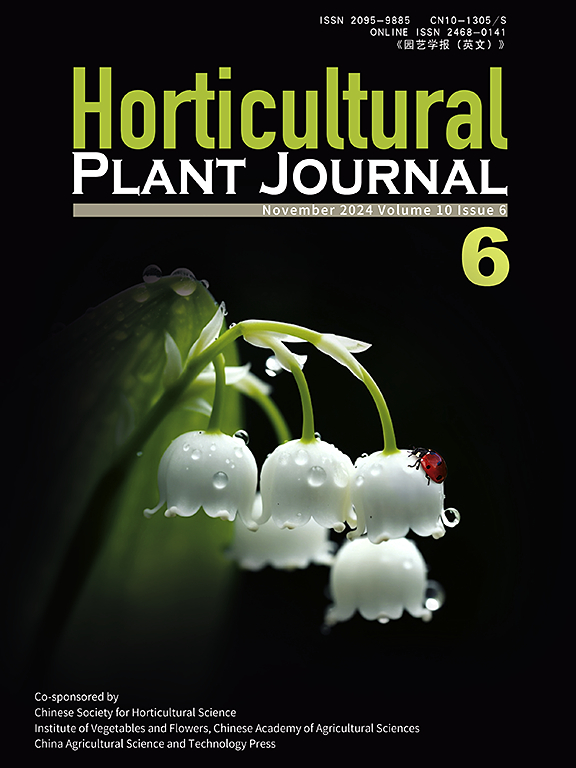番茄后期促进复合体/环小体亚基的鉴定与功能表征
IF 6.2
1区 农林科学
Q1 HORTICULTURE
引用次数: 0
摘要
后期促进复合体/环体(APC/C)是一种多单元e3连接酶,通过与泛素化蛋白相互作用来控制有丝分裂和非有丝分裂途径。然而,对番茄APC/C亚基的发育功能研究甚少。本研究共鉴定出番茄基因组中9个APC/C亚基,并通过VIGS基因沉默技术确定了它们在叶片和果实发育中的功能。蛋白质亚基间相互作用表明,番茄‘Heinz 1706’的APC/C结构与其他系统略有不同,其中APC8和APC10相互作用最多。沉默APC/C亚基导致番茄植株体积变小,株高、生物量、叶面积、花大小和果实大小显著降低。细胞学分析证实,APC/C亚基的沉默抑制了番茄叶片和果实的细胞分裂和扩增。流式细胞分析和有丝分裂指数分析证实了APC/C在调节细胞周期M期的积极作用,从而导致沉默植物细胞中DNA含量增加。APC1、APC2、APC4、APC11和CDC27a对花器官发育的影响最大。APC/C亚基的沉默使减数分裂不平衡导致花粉活力降低。APC4和APC6对果实成熟起重要作用,APC1、APC4和APC10对果实形状起调节作用。综上所述,我们的研究结果表明,APC/C通过调节有丝分裂和减数分裂对番茄发育至关重要,不同的亚基可能对某些组织发育有不同或更深远的影响。本文章由计算机程序翻译,如有差异,请以英文原文为准。
Identification and functional characterization of anaphase-promoting complex/cyclosome subunits in tomato
The anaphase-promoting complex/cyclosome (APC/C), a multiunit-E3 ligase, governs both mitotic and non-mitotic pathways by interacting with ubiquitinated proteins. However, developmental functions of APC/C subunits in tomato have been rarely studied. Here, we identified a total of nine APC/C subunits in tomato genome and established their functions in leaf and fruit development via VIGS gene silencing technology. Protein interactions between subunits revealed that tomato ‘Heinz 1706’ had a slightly different APC/C structure from other systems, in which APC8 and APC10 had the most interactions. Silencing APC/C subunits in tomato led to smaller plants with significantly reduced plant height, biomass, leaf area, flower size and fruit size. Cytological analyses confirmed that silencing APC/C subunits repressed both cell division and expansion in tomato leaves and fruits. Both flow cytometric and mitotic index analyses verified the positive role of APC/C in regulating M phase of cell cycle, which led to increased DNA contents in cells of silencing plants. APC1, APC2, APC4, APC11 and CDC27a had more impacts on the floral organ development than other subunits. Silencing APC/C subunits reduced the pollen viability due to unbalanced meiotic division. APC4 and APC6 were important for the fruit maturation while APC1, APC4 and APC10 modulated the fruit shape. Taken together, our findings illustrate that APC/C is essential for tomato development through the modulation of mitotic and meiotic division, and different subunits may have distinct or more profound impacts on the certain tissue development than others.
求助全文
通过发布文献求助,成功后即可免费获取论文全文。
去求助
来源期刊

Horticultural Plant Journal
Environmental Science-Ecology
CiteScore
9.60
自引率
14.00%
发文量
293
审稿时长
33 weeks
期刊介绍:
Horticultural Plant Journal (HPJ) is an OPEN ACCESS international journal. HPJ publishes research related to all horticultural plants, including fruits, vegetables, ornamental plants, tea plants, and medicinal plants, etc. The journal covers all aspects of horticultural crop sciences, including germplasm resources, genetics and breeding, tillage and cultivation, physiology and biochemistry, ecology, genomics, biotechnology, plant protection, postharvest processing, etc. Article types include Original research papers, Reviews, and Short communications.
 求助内容:
求助内容: 应助结果提醒方式:
应助结果提醒方式:


